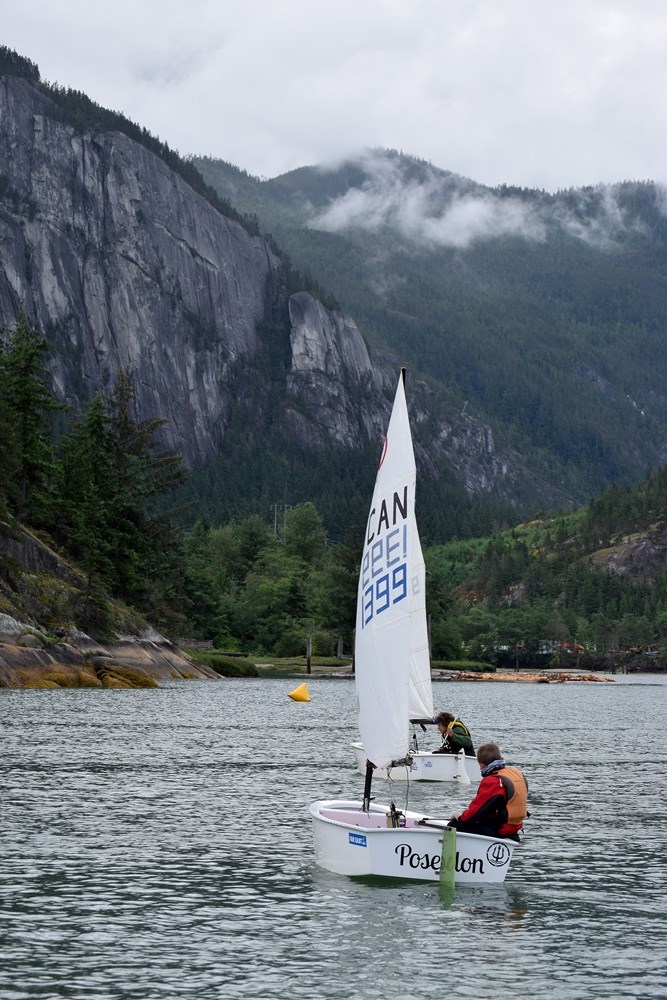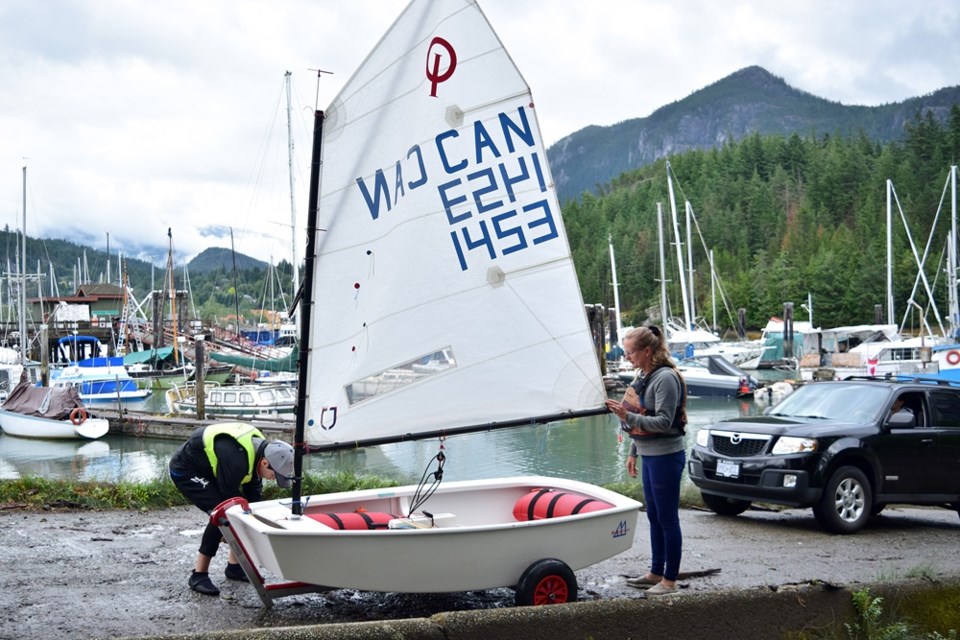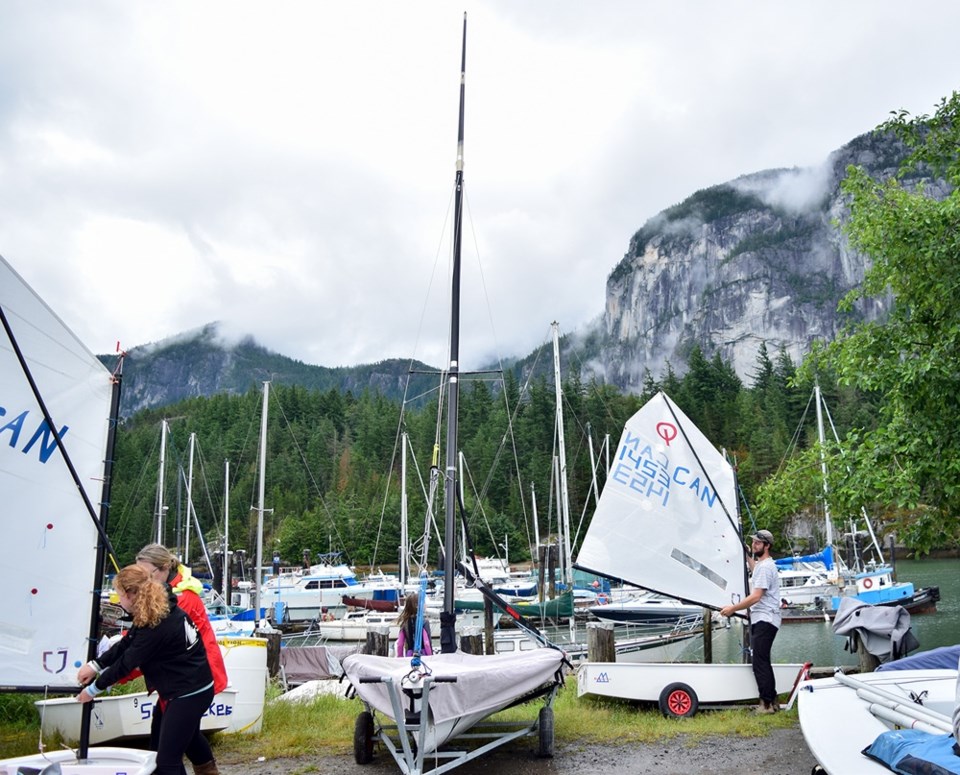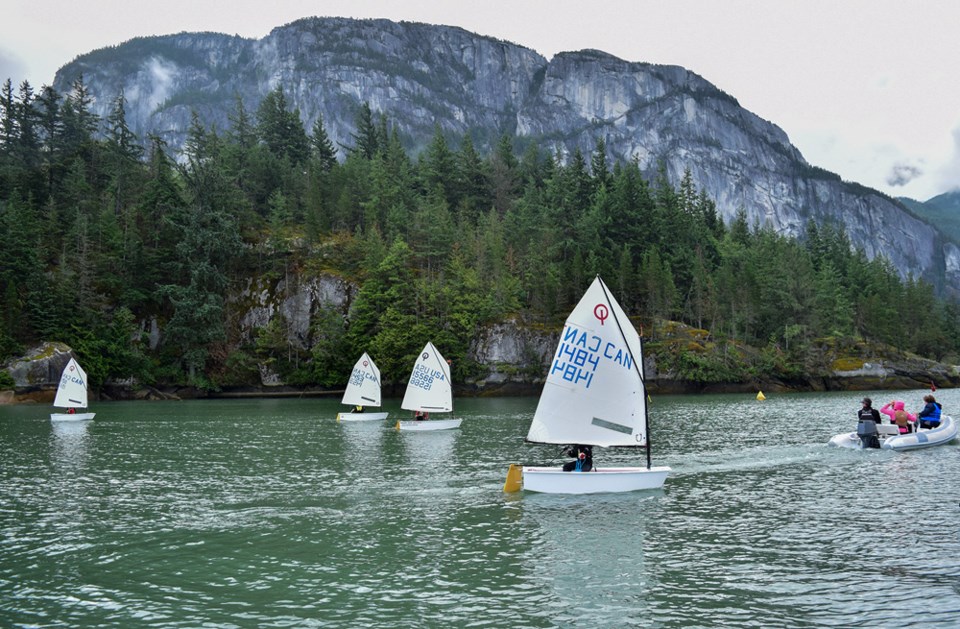On a cloudy Saturday in July, when the coast mountains flanking Howe Sound barely peeked through the mist, dozens of teenagers readied their one-person sailboats to launch into the Squamish Harbour.
With the boats arranged in haphazard rows in the Squamish Yacht Club’s parking lot, some spilling over onto the other side of the road, the kids unfurled sails in the mud. Family dogs yipped as parents looked on, some helping their kids and others looking amused by the organized chaos.
It was the BC Sailing Championships, and Squamish was hosting for the first time in three years. But the scene didn’t look like other regattas might at more established yacht clubs in Vancouver.
There, explained Garry Cotter with Sail Squamish, young sailors would be able to unroll their sails indoors. They’d even be able to change in a room instead of standing atop their boats. And they’d even be able to use a flush toilet instead of the row of porta-potties standing beside the wooden clubhouse.

“Everyone wants to sail in Squamish,” Cotter said. “It’s just like mountain biking, skiing — it’s one of those types. You’re out in nature … But the facilities here are limited.”
Cotter, 62, is a master sailor who’s known to throw his one-person Laser boat on the roof rack of his red Mini. He’s clearly one of the most knowledgeable people here, being approached to answer questions about everything from race heats to regatta T-shirts.
He knows Squamish is already an incredible sailing destination because of its reliable and powerful winds. The sport has come a long way since the days when the town had a predominantly industrial waterfront. He only wishes the sport’s potential could be fully realized by adding the proper facilities to make sailing here a smooth and seamless experience.
That’s why Cotter, and nearly everyone else in the Squamish sailing community, is excited about the new sailing centre that’s part of the proposed development plans for the former Nexen lands.
When it releases further details of the park — the company says it should be soon — Newport Beach Developments will have a few more specifics of the sailing centre plans.
Back at the regatta, Ben Sweeny, a 13-year-old sailor, explained that the youngest kids go first while the winds are still light. More advanced athletes like himself sail in the afternoon, when the winds get stronger.
The geography near Squamish means winds follow a daily cycle in the summer, promising good sailing most afternoons.
Armel Castellan, a meteorologist with Environment and Climate Change Canada, explained that as temperatures inland heat up throughout the day, cooler and denser air from the coast rushes in. The mountains surrounding Howe Sound act like a funnel to concentrate the gusts over the aquamarine water.
“Howe Sound is well placed because on the coast you’ve got a cooler body of water, mother nature’s A/C if you will, and you have the interior like Pemberton and Lillooet where temperatures increase,” he said.

At night, when air temperatures fall, winds move the opposite direction back out to sea.
Cotter recalls the 1976 Montreal Olympics that got a sailing centre built in Kingston, Ont. as the first time people wanted to make something similar happen in Squamish. But though the winds were there, the waterfront access was not.
“At that time you physically could not get to water in Squamish. It was just the chemical plant, BC Rail and logging,” he said. “There was nothing.”
Tine Moberg-Parker, a former Olympian and sailing coach, remembers sailing in Squamish gaining popularity in the early 2000s, when the Sea to Sky Highway made the Vancouver-Squamish connection quicker.
“We didn’t go there in the 90s,” she said. “It wasn’t developed and everybody thought it was too windy, too scary, too everything.”
But after the Nexen chlor-alkalki plant shut down in 1991 and remediation began in 2000, things picked up.
Now there’s a thriving learn-to-sail program run out of the yacht club every summer. Its 130 spots fill up within days of registration opening. Cotter loves how quickly kids can go from knowing nothing to controlling their own one-person Optimist dinghies.
He also points to the bursting learn to sail program as proof that interest in sailing is outpacing current resources.
Right now, he says there’s a bit of a missing link. Kids can learn to sail in Squamish, but once they get to a certain age and skill level, they have to move elsewhere.
Sweeny had to do just that. He lives in Squamish and grew up sailing there, but now he sails out of Royal Vancouver Yacht Club with its more robust junior sailing program and high-calibre coaches.
“I want to do the best I can, get as far as I can and sail for as long as possible,” he said.
Grayson Blann, 14, is in a similar position.
“There’s a lot of things I’d like to see change [about sailing in Squamish],” he said. “There isn’t really much in the way of, like, an actual racing centre for sailing. I mean there’s a yacht club and a clubhouse. But there isn’t much.”

With the new sailing centre, Cotter hopes talent will flow the other way, with accomplished sailors flocking to Squamish instead of leaving it.
Besides the racing circuit filled with athletes, there’s also a community of big boat pleasure sailors who love taking to the water in Squamish. Christina Botros joined it when she bought a boat with her boyfriend.
“We call it our loveboat,” she laughed. “Because our relationship started with this dream of sailing. So we bought this condemned boat, and we’ve pretty much been renovating it from the bottom up.”
Right now, she’s waiting for a spot to moor it at the Squamish Yacht Club.
“I think it represents freedom,” she said. “You can go wherever. You can use the power of the wind to get you there. You don’t need a motor, and you don’t need to rely on gasoline.”
Cotter has a big boat too, but he thinks smaller racing boats are more fun — and are better teachers.
“You can make mistakes in big boats and not know it until you’ve run into a difficult situation,” he said. “In a small boat, if you make a mistake you swim.”
The kids at the BC Sailing Championships mostly readied Optimists, one of the most popular boats for kids to learn to sail. They’re built standard all over the world, and competitors aren’t allowed to spend money to make the boat better. The Optimist’s race performance is supposed to purely be a reflection of skill.
Older kids readied their Lasers and 29ers. Athletes were there from all over Canada, and some had their sights set on the Olympics one day.
Moberg-Parker watched several of her mentees race. Some little ones were competing in their very first regatta. In every race up until the Olympics, boys and girls compete together. She likes the equal footing it gives kids in that way.
She also likes the sense of freedom the sport gives.
“There are no walls and no roof. I think that’s what the kids like most,” she said. “Squamish has the beautiful mountains, the waterfall. the Chief and the different coloured water. It’s like playing with nature.”




